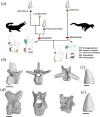A South American sebecid from the Miocene of Hispaniola documents the presence of apex predators in early West Indies ecosystems
- PMID: 40300627
- PMCID: PMC12040450
- DOI: 10.1098/rspb.2024.2891
A South American sebecid from the Miocene of Hispaniola documents the presence of apex predators in early West Indies ecosystems
Abstract
The absence of terrestrial apex predators on oceanic islands led to the evolution of endemic secondary apex predators like birds, snakes and crocodiles, and loss of defence mechanisms among species. These patterns are well documented in modern and Quaternary terrestrial communities of the West Indies, suggesting that biodiversity there assembled similarly through overwater dispersal. Here, we describe fossils of a terrestrial apex predator, a sebecid crocodyliform with South American origins from the late Neogene of Hispaniola that challenge this scenario. These fossils, along with other putative sebecid specimens from Cuba and Puerto Rico, show that deep-time Caribbean ecosystems more closely resembled coeval localities in South America than those of today. We argue that Plio-Pleistocene extinction of apex predators in the West Indies resulted in mesopredator release and other evolutionary patterns traditionally observed on oceanic islands. Adaptations to a terrestrial lifestyle documented for sebecids and the chronology of West Indian fossils strongly suggest that they reached the islands in the Eocene-Oligocene through transient land connections with South America or island hopping. Furthermore, sebecids persisted in the West Indies for at least five million years after their extinction in South America, preserving the last populations of notosuchians yet recovered from the fossil record.
Keywords: Caribbean; Sebecus; biodiversity museum; extinction; palaeobiogeography.
Conflict of interest statement
We declare we have no competing interests.
Figures


Similar articles
-
The phylogenetic position of ridley's worm lizard reveals the complex biogeographic history of New World insular amphisbaenids.Mol Phylogenet Evol. 2022 Aug;173:107518. doi: 10.1016/j.ympev.2022.107518. Epub 2022 May 14. Mol Phylogenet Evol. 2022. PMID: 35577297
-
Early Oligocene chinchilloid caviomorphs from Puerto Rico and the initial rodent colonization of the West Indies.Proc Biol Sci. 2020 Feb 12;287(1920):20192806. doi: 10.1098/rspb.2019.2806. Epub 2020 Feb 12. Proc Biol Sci. 2020. PMID: 32075529 Free PMC article.
-
Hydroids (Cnidaria, Hydrozoa) from Mauritanian Coral Mounds.Zootaxa. 2020 Nov 16;4878(3):zootaxa.4878.3.2. doi: 10.11646/zootaxa.4878.3.2. Zootaxa. 2020. PMID: 33311142
-
The West Indies as a laboratory of biogeography and evolution.Philos Trans R Soc Lond B Biol Sci. 2008 Jul 27;363(1502):2393-413. doi: 10.1098/rstb.2007.2068. Philos Trans R Soc Lond B Biol Sci. 2008. PMID: 17446164 Free PMC article. Review.
-
An overview of the South American fossil squamates.Anat Rec (Hoboken). 2014 Mar;297(3):349-68. doi: 10.1002/ar.22858. Epub 2014 Jan 31. Anat Rec (Hoboken). 2014. PMID: 24482358 Review.
References
-
- Fernández de Castro M. 1864. De la existencia de grandes mamíferos fósiles en la isla de Cuba. An Real Acad Cien Méd, Fís Nat de La Habana 1, 17–21.
-
- Wallace AR. 1880. Island life: or, the phenomenon and causes of insular faunas and floras, including a revision and attempted solution of the problem of geological climates. London, UK: Macmillan. (10.5962/bhl.title.98129) - DOI
-
- MacPhee RDE, Iturralde-Vinent MA. 1995. Origin of the greater Antillean land mammal fauna, 1: new tertiary fossils from Cuba and Puerto Rico. Am Mus Novit. 3141, 1–31.
-
- Iturralde-Vinent MA, MacPhee RDE. 1999. Paleogeography of the Caribbean region: implications for Cenozoic biogeography. Bull. Am. Mus. Nat. Hist. 238, 1–95. (10.1206/0003-0090) - DOI
-
- Iturralde Vinent MA, MacPhee RDE. 2023. New evidence for late eocene-early oligocene uplift of aves ridge and paleogeography of GAARlandia. Geol. Acta 21, 1–10. (10.1344/geologicaacta2023.21.5) - DOI
MeSH terms
Grants and funding
LinkOut - more resources
Full Text Sources
Miscellaneous

